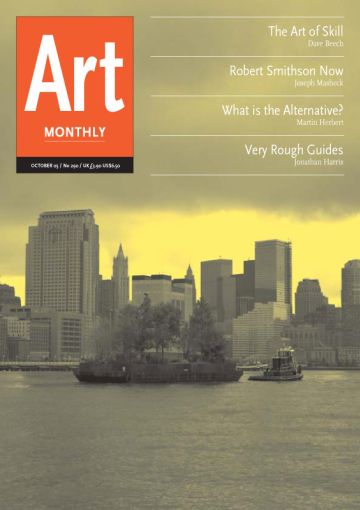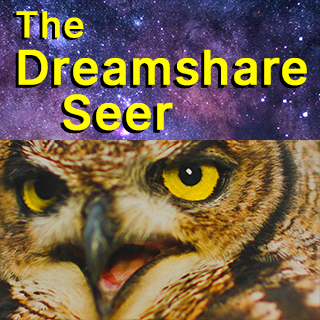Feature
Robert Smithson Now
For all its environmental, theoretical and literary significance Smithson’s work was above all visual insists Joseph Masheck
Robert Smithson is in the surveys as author of, plausibly, the most radical work of sculpture since Picasso’s 1912 Guitar, namely Spiral Jetty from 1970, which still extends out from the shore into the Great Salt Lake in Utah. The piece, which sums up a lot of the artist’s musing on big and slow, cosmological as well as geological time, was made, truckload by truckload, by backing up a dumptruck full of loose rock from close by and unloading it into the lake.
It has something of a mysterious as well as a heroic standing in latterday art discourse, not only because it is so remote that it has sometimes been misconstrued as ‘conceptual’ just for that; but because over the past generation the level of the lake first rose and swallowed it up, then lowered, giving it back.
The artist’s larger project – which was not so much conceptual as concerned with what was called ‘head stuff’ around 1970 – has been celebrated with a major retrospective exhibition that originated at the Museum of Contemporary Art, Los Angeles. ‘Robert Smithson’, organised by Eugenie Tsai with Cornelia Butler, brought together upwards of 200 works, including some early paintings, many drawings, and Smithson’s Spiral Jetty film which mythopoetically as well as pragmatically accounts for the famous sculpture’s making. Over all, Smithson’s art was seen to develop from a steamy religious expressionism, through a naughty dalliance with what now would count as ‘queer’ art and experiments in an abstract Pop of sorts, into ‘Minimalism’ and beyond.
Despite creditable contributions to Minimalism, Smithson’s drive was pushing him beyond it with, if anything, a sort of freaked Minimalism, as one then said. These particular works do not sit tight as mute boxes, but misbehave, as by marching ‘pointlessly’ into perspective, for instance, in the large painted steel Pointless Vanishing Point, 1967. It was gratifying to see such other major pieces that go ‘over the top’ of Minimalism as a 2003 reconstruction of the famous but lost Enantiomorphic Chambers, 1965, in which, by mirror-interplay, the return of the repressed illusionism banished from modernist painting effects a conundrum real enough for the department of physics. It was also instructive to see, especially with the classic Non-Sites, how fabrication of the sheet-metal pieces might sometimes have had to be less than ideal, though not povera, and yet be fine in a real-world way, unlike the minimalist desire to effect a perfect blank. It was in taking the rough earth itself for his sculptural metier, with such a fleshy sense of its reality as a matter of virtually bodily stuff, that Smithson comes to be identified as a postminimalist.
All this happened in New York before the concept of Postmodernism was in place, though it should not be forgotten how current the outlook of the Beat Generation, which was not only literary or even aesthetic but political, still was. From that angle, Smithson was an inevitable annoyance to an art world dominated by the inhibitedly conformist-assimilationist good taste of (tedious term) ‘Greenbergian formalism’. By themselves, the early paintings could be characterised as garage-band CoBrA, while the collages evoked Allen Ginsberg; but they could never have put Smithson on the map. It was by virtue of the ostensive sculpturality of his Non-Sites and the sheer sculptural grandeur of Spiral Jetty that Smithson could not be contained by any identification of him as a licensed eccentric of extended but essentially literary culture.
He did also write, of course, in a way that braided with his visual art. His most important text as such was his 1967 photo-essay ‘Monuments of the Passaic’, which makes that dump of a river an occasion of aesthetic delectation, precisely in its rustbelt demise. Although he is known to have been stimulated by Chris Marker’s La Jetée, 1962, we were all prepared for it by the quasi-sublime industrial decadence of Michelangelo Antonioni’s Red Desert, 1964. Today, when much of New York has had its old hardware replaced in Disneyesque tidy-ups to suit an essentially suburban business mentality, it is ironically refreshing to be put in mind of Smithson’s genuine aesthetic fascination with the stinky Passaic River, into which rusted pipes, for all I know, still dribble their iridescent pollutants. (I have always found it amusing when literary folk try to make the Baudelairean Smithson relevant by trying to frame the Spiral Jetty and other earthworks in happy-faced environmentalist terms.)
Now as it is, I feel almost irresponsible in having to report, without being able to read every page, that the exhibition has nine essays, not counting an interview, a catalogue of the artist’s library and still another essay on that library’s catalogue. The longest piece, by Thomas Crow, engages eruditely with the more religious (not vaguely ‘spiritual’) implications of the artist’s production. (Some might think that this makes Smithson into a theological idiot-savant, but much of the arcana which Crow negotiates was still widely taught to teenagers in the 50s.) This formidable reading adds something appositely sophisticated to the standing conviction that, even if Smithson’s brainy-nerdy play with science and such was attenuated-adolescent, it was so deepset and wideranging as to make him the most brilliant autodidact in later 20th-century American art.
But perhaps we now face a challenge in the study of Smithson given that, since his time, there is no longer any difficulty either with the hermeneutical intentionality of a work, or with an ‘open’ work as inviting, more than receptive corroboration, readerly collaboration. One hopes that the study and critique of Smithson does not become as academic and boring as the intellectual business of Duchamp now often seems. Notwithstanding its mesmerising appeal to the literary, Smithson’s diastrophic talk (in the now old-fashioned term for mountain-building by sedimentation) about silting language was in the service of a visual imagination made manifest in some great art – besides the one drawing, A Heap of Language, 1966, which has been inordinately appealed to, usually without even accounting the image. I think that in this case the art-historically readerly needs to take the problem away from the literally (and even ‘theoretically’) readerly, because that is where Smithson remains provocative and stimulating for all who really care about art.
What is called for, I have long thought, is more of a visual Random Access Memory, specifically an art-readerly approach to Smithson’s work, whereby, to paraphrase the famous notion of TS Eliot of which Smithson was well aware, new art can drag art history along behind, as if retroactively. At the risk of harping on my own thing, let me point to the 1970 Partially Buried Woodshed. First, however, I cannot ‘play back’ farther in culture without mentioning (assuming no one has) that there are grounds for an inference that Smithson would have been aware of Graham Greene’s 1957 play The Potting Shed which was immediately published in a New York magazine. But I don’t want to track that further because what I really want to say is that Partially Buried Woodshed is rather a major blast from the art-historical past in light of Caspar David Friedrich’s Snow-Covered Hut, c1827; and if necessary we can add that, though having before been only a concern of art historians, Friedrich was just then looking immediately and amazingly cool – finding a ‘re-entrance’, à la George Kubler’s The Shape of Time: Remarks on the history of things, 1962.
I would expect this exhibition to prove stimulating to young artists, as one of those exhibitions always mentioned way down the line in the history of something else. And if it is not just wishful thinking that the unknown ‘else’ might be something somehow like the liberationist spirit of the old Beats, which the present soft-fascist culture could desperately use, I must say that the Whitney Museum already deserved applause for its excellent presentation about a year ago of Jay de Feo’s ultra-Beat painting The Rose, 1958-66, now in the permanent collection. As a special supplement to the Whitney venue the Minetta Brook Foundation arranged for the execution and literal launch of a Smithson project never before realised, the 1970 Floating Island to Travel Around Manhattan Island, in which he proposed that a small barge planted with trees and vegetation be towed all day round and round the island, by a tugboat.
Like everything participating in art, Floating Island proved to have its relations. Many would now think of The Gates, as installed by Christo & Jeanne-Claude in Central Park last winter: an urban fiesta, happy, yes, but with an air of now familiarly corporate spectacle, sans logos. Vito Acconci’s anchored, steel-framed, glassy Island in the Mur, 2003, at Graz (conceived by Robert Punkenhofer of Art & Idea), is a distant cousin of Floating Island but by now architecturally normal (see AM287). Finally, on the launch day of Floating Island on September 17, I watched it sail in a breeze up the Hudson like a big quiet windowbox, its planting rather too tidy and pat for the germinal idea. I watched from the quasi-public park at the foot of Battery Park City, a huge dormitory complex for young Wall Street. Sailing past the hundreds in jogging gear, the work, with its tug pulling the thing along, looked just too toy-like, a Macy’s Parade version of Alice Shankey’s children’s book Tuffy the Tugboat, 1947. Then I realised that all the land around me was landfill anyway, including lawns as ‘perfectly’ unnatural as astroturf. The tables were quite turned on a wandering sample of 1970 New York – now almost as bad as ‘new and improved’ Dublin. Executing the project had seemed like a good idea, even maybe a great New York idea. At least the 2005 Floating Island made Alan Sonfist’s little Time Landscape: Reflection, ongoing since 1965 – just a plot planted with native species – seem more surreptitious than ever, and now almost archivally funky.
Robert Smithson was at MOCA, Los Angeles in 2004; Dallas Museum of Art in spring 2005 and at Whitney Museum of American Art, New York from June 23 to October 16 2005.
Joseph Masheck’s most recent book is C’s Aesthetics, 2004, on Cézanne’s approach to painting; he is working on a book on Adolf Loos.
First published in Art Monthly 290: October 2005.









